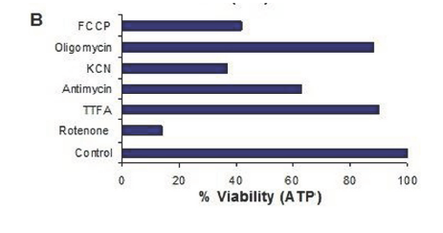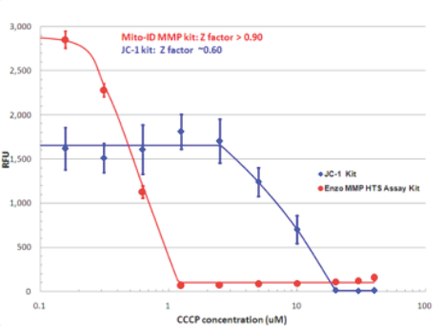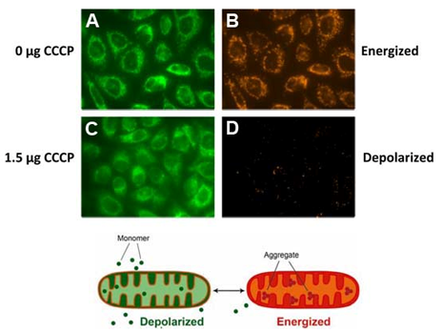High-Throughput Assays for Mitochondrial Function

MITO-ID® Extracellular O2 Sensor Kits
This oxygen-sensitive phosphorescent probe can be used to assess O2 consumption by cultured cells, isolated mitochondria, microorganisms, tissues, and enzymes.
- Phosphorescent probe increases in signal intensity with O2 consumption (▼ O2 levels)
- Amenable to 96- and 384-well microplates for high-throughput analysis on standard fluorescence plate readers (Ex/Em 380/650nm)
- Cell permeable probe also available for tracing intracellular O2 levels
- Multiplex with MITO-ID® pH Sensor probe to confirm mitochondrial toxicity
Detect Mitochondrial Dysfunction Within Minutes of Treatment
Assessment of mitochondrial function with MITO-ID® Extracellular O2 Sensor Kit (A) or traditional ATP assay (B) following treatment with mitochondrial inhibitors (Oligomycin, Rotenone, Antimycin), uncoupling agent (FCCP), or control (DMSO). Results illustrate that drug-induced mitochondrial
dysfunction is evident immediately post-treatment (A) despite varying levels of viability @ 24 hours by ATP assay (B).
MITO-ID® Extracellular pH Sensor Probe
This pH-sensitive phosphorescent probe can be used to monitor cellular acid extrusion, the result of increased glycolytic flux associated with mitotoxicity.
- pH sensitive probe increases in signal intensity with increasing acidity
- Simple mix-and-read protocol for 96-well microplates
- Amenable to standard fluorescence plate readers (Ex/Em 340/615nm)
Efficiently Monitor Glycolytic Activity
Acidification profiles of HepG2 cells treated with glucose transport inhibitors (2DG, Oxamate) or mitochondrial inhibitor (Antimycin) relative to control.
MITO-ID® Membrane Potential Cytotoxicity Assay Kit
A real-time mitochondrial membrane potential assay with superior sensitivity
- 10X more sensitive than JC-1 with superior aqueous solubility
- Photostable dual-emission dye
- No-wash/no-medium removal
- Separate MITO-ID® Red/Green assays available for detection of mitochondrial mass
- Suitable for high-throughput applications
Detect MMP Perturbations with 10X More Sensitivity than JC-1
Dual-emission Dye Monitors Energetic Status














